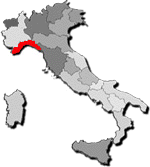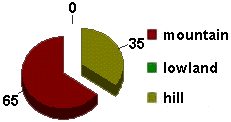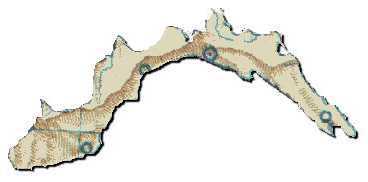 |
LIGURIA |
 Back to Italy |
| Provinces
- This region has 4 provinces: Genova, Imperia, La Spezia, Savona Chief town - Genova Surface - kmq 5416 National Parks - Any national parks  Russian Version |
 |
|
|
||
 |
LIGURIA |
 Back to Italy |
| Provinces
- This region has 4 provinces: Genova, Imperia, La Spezia, Savona Chief town - Genova Surface - kmq 5416 National Parks - Any national parks  Russian Version |
 |
|
|
||
 |
Origin of the Name |
| Reliefs - Passes - Coasts - Islands | |
| Landscape | |
| Agriculture - Stock-Farm - Fishing | |
| Industry - Tourism | |
| Position and Frontier | |
| Rivers - Lakes | |
| Climate | |
| Population | |
| Communication |
Origin of the name:
2000 years ago the comprehensive region of the actual
Piedmont and the Lombardy were already inhabited by the Liguris. Also Torino
(from the Latin ‘August Taurinorum ') belonged to Liguria which was under the
control of the Romans.
The coast Ligure is divided into: the West coast from Genoa entending further westward and the Rising Coast from Genoa and extending eastward. The west coast is formed by a number of rocky inlets, rocky promontories and by narrow and sandy beaches, while in the east are there are promontories with are thicker and lean more. More distant from the coast we find the few islands of which are more notable are the island Gallinara, the island Bergeggi, the islands of Palmaria and those of Tito and Tinetto.
Landscape:
A big part of the territory is mountainous and hilly,
dug from spacious and sinuous valleys until they go down into the brief band of
coastal lowland. The mountainous zone introduces itself arid and deprived of
vegetation. In the zones of country there are a few isolated houses. The urban
agglomerations are built very distant from each other, often above to the big
hills. Even if the Region is bathed from two seas, great harbors don't exist,
and therefore this area lacks big urban centers.
Agriculture - Stock-farm-
Fishing:
The formation of the ground limits a lot of
agricultural activity, the very narrow cultivable part has already been used by
the industrial establishments and by tourist fittings. There is a favorable
climate, that allows some narrow but very profitable crops such as the
cultivation of flowers,ornamental plants, fruit and vegetables. The most
diffuse products are: tomatoes, artichokes, asparaguses, fish, apricots
especially in the plain of Albenga, oil in Oneglia, wine in the Five Earths and
in the Imperia zone of . All these products are very limited and they don't
constitute source of profit for the Region. Even if the whole population lives
in the coast, fishing has been of little importance in the economy of Liguria,
because of the composition of the backdrops in some coasts, that immediately
fall to forbidden depths, for the few types of fish that can be found, such
as Sardinians, clearances and anchovies.
Position and Frontier:
Liguria is found in the slope of the tirrenico Alps,
Marittime and Appennino Ligure; it has a conformation of a narrow arc that
forms the Gulf of Genoa. It borders to north with Piedmont and Emilia Romagna,
to east with Tuscany, to south it is bathed from the Ligure Sea and to west it
borders with France.
Rivers - Lakes:
The rivers of Liguria are above of torrential
character. The principal are Roja that begins in France and leads in the press
of Ventimiglia,and Impero which flows to Oneglia, and Arroscia that flows
to Albenga, Letimbro in the zone in Savona. The river Vara is the longest of
and meets with Magra in Tuscany. Also notible are Tanaro, Bormida and Scrivia
that are born from Appennino Ligure and meet in Po. The same is for
Trebbia and Staffora.
Climate:
The climate is mild thanks to the sea breezes that
refresh in summer and mitigate in winter and to the mountainous chains that
protect the coast from northern colds. This climate is ideal for an evergreen
vegetation as the maritime pine, the ulivo, the palms, the cypresses and the
laurel.
Population:
Although all mountainous, this is not earth of
mountaineers, but of dealers and sailors. Liguria is densely a populated
region, but the greatest part of it resides along the coast, where the
principal cities rise. Half of the population is concentrated in Genoa.
Communication:
The railway net is one of the points of strength of the
communications of Liguria; it connects all the clearings of central Italy,
southern from Florence and further north that arrive from Milan going toward
the Blue Coast in France. Along the coast is the street Aurelia, built by
Romans to reach Gallia, while parallel to Aurelia the highway that reaches her
Spezia and colleague Sestri Levante-Genova-Savona-Ventimiglia which then
continue in the French territory from Pisa races. There are other highways that
connect Genoa to Milan, Savona with Turin and Spezia to Parma. From Genoa there
are the principal lines of a ships port for Sardinia and the harbors of the
countries of Mediterranean. The principal airport is situated in Genoa-Sestri.
Web Site designed by MediaSoft - © Copyright 1998-1999 - All rights reserved